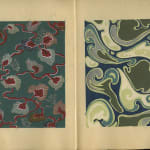





Shin Bijutsukai Volume 15, 1902
Bound collection of woodblock prints on paper
9-1/2”H x 6-1/2”W
Publisher: Yamada Unsodo, Kyoto Designer: Furuya Korin
Further images
Shinbijutsukai, a monthly periodical design idea book, Zuancho, was published in 1902 for 15 years in 36 volumes. It was designed by Korin Furuya, supervised by Sekka Kamisaka, and published...
Shinbijutsukai, a monthly periodical design idea book, Zuancho, was published in 1902 for 15 years in 36 volumes. It was designed by Korin Furuya, supervised by Sekka Kamisaka, and published by Unso-do
It is one of the pinnacles of Zuancho, in my opinion.
The Meiji Restoration, which started in 1868, opened the country to the western world and rapid Westernization started. Interestingly, there was a difference or gap in handling the changes in aesthetics between Tokyo and Kyoto. In Tokyo, they were eager to change to get the most commercial success in exporting ceramics or lacquer wares catering to western likings. In Kyoto, they were more focused on changes merging with tradition. The difference is apparent when we compare Meiji ceramics produced in Tokyo for export and Zuancho, which digested the western aesthetics of the period but focused on domestic consumption, namely the Kyoto Kimono buyers.
The result? The export goods of the era show the historical footsteps but now they are not considered timeless beauty. The Zuancho designs, on the other hand, look fresh, and we can certainly adapt them to the 21st century.
It is one of the pinnacles of Zuancho, in my opinion.
The Meiji Restoration, which started in 1868, opened the country to the western world and rapid Westernization started. Interestingly, there was a difference or gap in handling the changes in aesthetics between Tokyo and Kyoto. In Tokyo, they were eager to change to get the most commercial success in exporting ceramics or lacquer wares catering to western likings. In Kyoto, they were more focused on changes merging with tradition. The difference is apparent when we compare Meiji ceramics produced in Tokyo for export and Zuancho, which digested the western aesthetics of the period but focused on domestic consumption, namely the Kyoto Kimono buyers.
The result? The export goods of the era show the historical footsteps but now they are not considered timeless beauty. The Zuancho designs, on the other hand, look fresh, and we can certainly adapt them to the 21st century.
Signup for our Newsletter
You will receive two emails a month from us. One introduces artworks and design works from Kyoto's hidden sources and the other is stories from Misako, sharing insights into Japanese culture.
* denotes required fields
为了回应您的查询,我们将根据我们的隐私政策处理您提供的个人数据。





